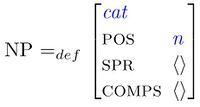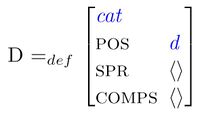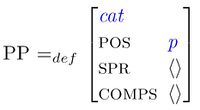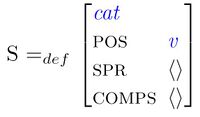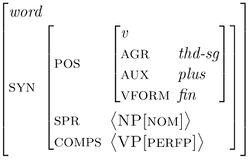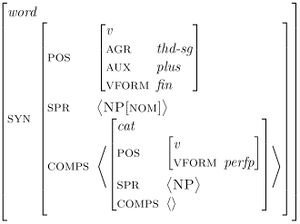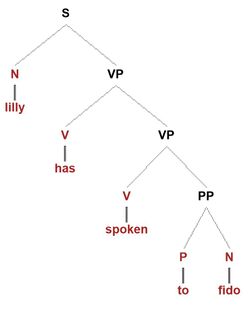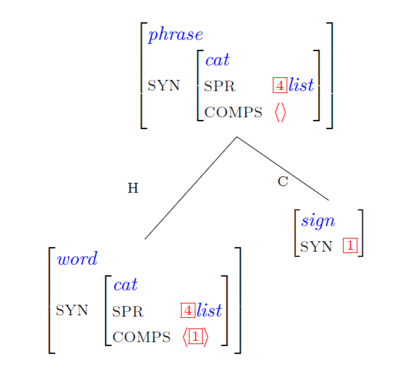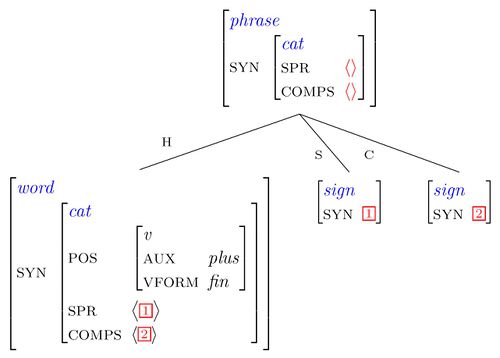Syntax 1 Wiki: Week 6
Abbreviations
To make life easier on us, we use a number of abbreviations in valence lists, e.g. NP, PP, etc. In the next exercise you are supposed to find out which feature structures each of these abbreviations stand for. To this end, do the following exercises.
- Go to the online grammar.
- Click on the lexical entry for amuse.
- Click on the tree.
- There are two NP-nodes in the verb's valence lists.
- Open both of them and find what the two feature structures have in common. That is what the symbol "NP" abbreviates.
Exercises
(1) Which feature structure does the symbol "NP" stand for?
Now follow the same procedure for the abbreviatory symbols below.
(2) Which feature structure does the symbol "D" stand for?
(3) Which feature structure does the symbol "PP" stand for?
(4) Which feature structure does the symbol "VP" stand for?
(5) Which feature structure does the symbol "S" stand for?
Auxiliaries
Through the feature AUX, we can distinguish auxiliaries from main verbs. This is necessary because in English auxiliaries have a number of syntactic properties that sets them sharply apart from main verbs.
Illustration:
1. Auxiliaries, but not main verbs, can appear before the negation:
- Lilly has not spoken to Fido.
- *Lilly spoke not to Fido.
2. Auxiliaries, but not main verbs, can appear before the subject in Yes-no questions:
- Has Lilly spoken to Fido?
- *Spoke Lilly to Fido?
The syntactic contexts where only auxiliaries can appear are therefore marked [AUX +].
Exercise
Using the abbreviations introduced in the last section, write a lexical entry for the auxiliary has as it is used in the following sentence:
Lilly has seen the movie.
Now let us be more precise and expand the symbol "VP" in the entry above. What will the result be?
The lexical entry of has with the symbol "VP" spelled out
- Go to the online grammar.
- Display the lexical entry of has and convince yourself that it is the same as above.
Exercise
- Write down by hand the lexical entry of the progressive auxiliary is.
- Now go to the online grammar.
- Display the lexical entry of is and check your answer.
Exercise
- Write down by hand the lexical entry of the progressive auxiliary will.
- Now go to the online grammar.
- Display the lexical entry of will and check your answer.
Exercise
- Go to the online grammar.
- Type in the sentences below one by one and predict what the result will be.
- Explain what the result is in each case.
- (1) Lilly has spoken to Fido.
- (2) Lilly has speak to Fido.
- (3) Lilly has speaking to Fido.
- (4) Lilly is spoken to Fido.
- (5) Lilly is speak to Fido.
- (6) Lilly is speaking to Fido.
- (7) Lilly will spoken to Fido.
- (8) Lilly will speak to Fido.
- (9) Lilly will speaking to Fido.
Polar interrogatives (= Yes-no questions)
Recall that one position where English requires an auxiliary and bans main verbs is the first position in yes-no questions:
(1) Has Lilly spoken to Fido?
(2) *Spoke Lilly to Fido?
Let us now capture this generalization with our grammar. We begin by recalling the lexical entry of the auxiliary has:
Has wants to combine with a nomivative NP as a specifier and a perfect VP as a complement. In order to license declarative sentences like
(3) Lilly has spoken to Fido
has is first unified with the head position of the Head-complement phrase, where it combines with its VP-complement, and the resulting finite VP combines with a nominative NP to form a sentence.
So, with the use of the Head-complement and the Head-specifier schema we will only be able to license the word order
- SUBJ AUX VP
and not the order
- AUX SUBJ VP
which we need for sentence (1).
The Subject-Auxiliary-Inversion (SAI) schema
So, we have no choice but to add a third schema to our grammar. This is what you are supposed to do in the next exercise.
When writing a new schema, it is usually a good idea to look at a schema which licenses similar strings and to think about the question of how you would have to change the first schema into a new one that does what you want. In the present case, we want to license sentences of a head (= the auxiliary) which is followed by its specifier (= the SUBJ) and its complement (= the VP) in that order. Of the two schemas which we already have, the Head-complement schema is closest to what we need. Here it is one more time:
Exercise
By hand, write a new schema that fulfills all the following conditions:
1. The mother is a phrase.
2. The first daughter is the head daugher is marked as a finite auxiliary.
3. The second daughter realizes the head daughter's SPR valent.
4. The third daughter realizes the head daughter's COMPS valent.
5. Make sure to give the mother's values for its two valence features!
Here is the solution:
(1) The Subject-Auxiliary-Inversion schema
Exercise
- Go to the online grammar.
- Type in the sentences below one by one and predict what the result will be.
- Explain what the result is in each case. If a sentence is ungrammatical, then pinpoint the exact reason.
- (1) Has Lilly spoken to Fido.
- (2) Has Lilly speak to Fido.
- (3) Has Lilly speaking to Fido.
- (4) Is Lilly spoken to Fido.
- (5) Is Lilly speak to Fido.
- (6) Is Lilly speaking to Fido.
- (7) Will Lilly spoken to Fido.
- (8) Will Lilly speak to Fido.
- (9) Will Lilly speaking to Fido.
- (10) Will she speak to Fido?
- (11) Will her speak to Fido?
- (12) Has I spoken to Fido?
- (13) Have she speak to Fido?
Exercise
So far, we have ignored VPs in which a main verb combines with two complements:
(14) (Lilly) [VP gave an apple to Fido].
(15) (Lilly) [VP gave Fido an apple].
Write a schema that will license the VPs above.
Navigation:
